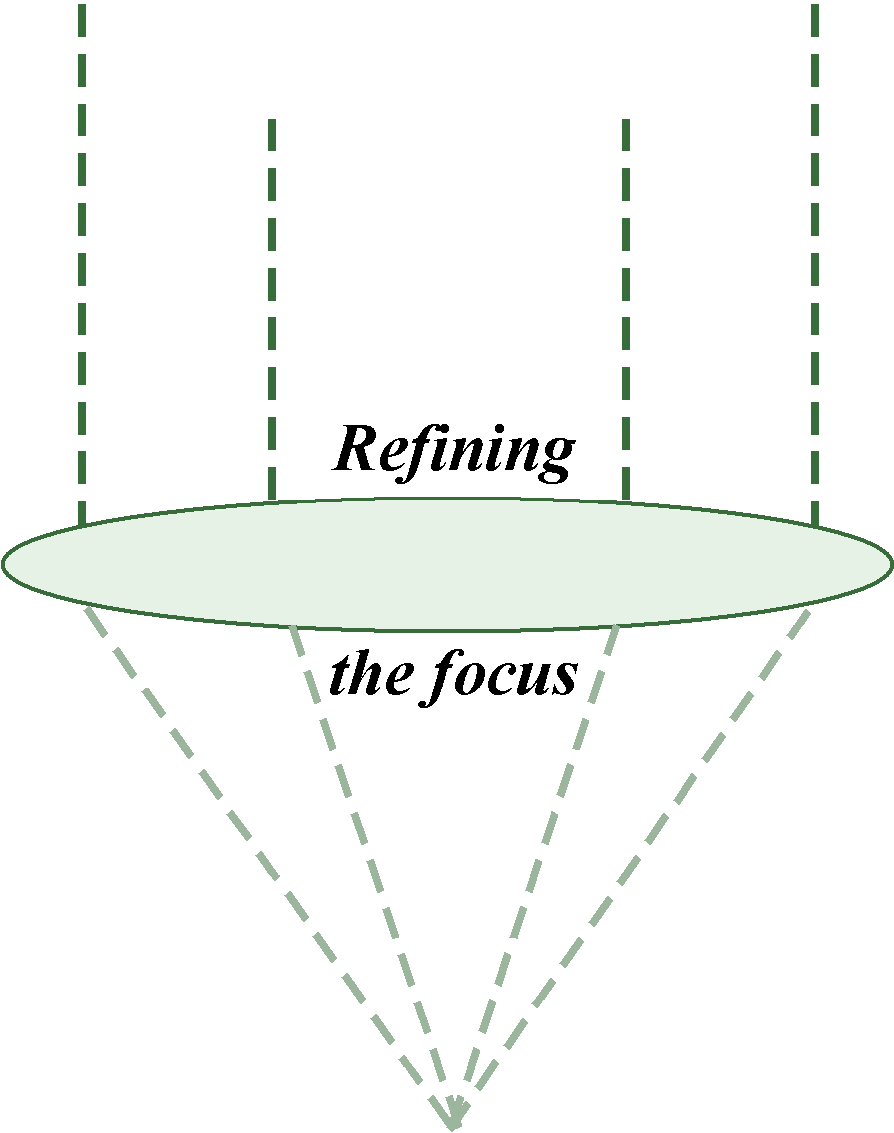
Global IEEE Power United Nations Conference International Conference on Large
High-Voltage World Energy Conference Global
Tapping Remote Renewables —
|
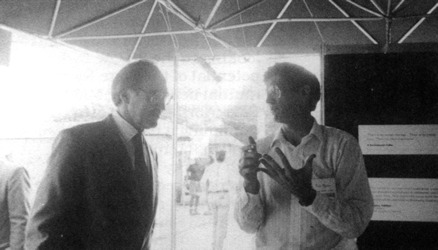 |
|
|
What if you had a crystal ball? Of course you would want to know the future. This year, GENI has been good-fortuned. We have received enough pieces of our global puzzle to be able to project a reasoned forecast.
On some issues, the trends are clear. The prediction is very alarming. How our world leaders decide to deal with those issues is critical.
Just as cancer takes many years to be recognized in our bodies, the energy and environmental choices we make today will determine our planet's health over the next twenty to thirty years. Many experts have said that a shift to sustainable development over this period is essential, or the treatment may be too late.
World Population vs. Energy Demand
Our global population continues to grow at accelerated rates. We now add a billion people in just one decade. This is most striking when you realize that we only had 2.5 (?)billion at the beginning of this century, compared to 5.4 billion today.
Driven predominately by developing nations, world population will almost double, and so will energy demand.
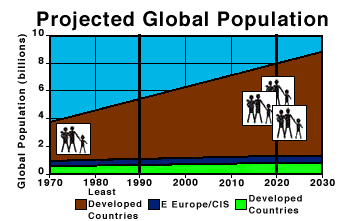 Nearly
all of this population increase will come from the
developing countries. Just as noteworthy, once a society
reaches an adequate living standard, the rate of growth
levels off. Many development specialists feel that
the only way to curtail the birth rates in developing
nations is to help those people improve their living
standards as quickly as possible.
Nearly
all of this population increase will come from the
developing countries. Just as noteworthy, once a society
reaches an adequate living standard, the rate of growth
levels off. Many development specialists feel that
the only way to curtail the birth rates in developing
nations is to help those people improve their living
standards as quickly as possible.
Figure 1 - Projected Global Population
The demand for energy seems to follow an almost identical trend. The new people will escalate the demand for energy, while first and second world economies have learned to be more efficient with resources. Being able to do "more with less" is a natural law, once you have gone beyond basic subsistence.
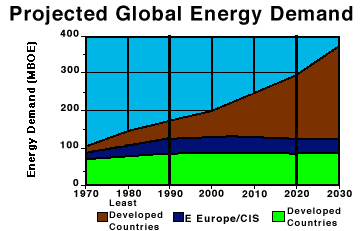 Figure
2 - Projected Global Energy Demand
Figure
2 - Projected Global Energy Demand
Ideally, this new energy production would build upon the knowledge and technology already experienced by developed economies. However, two of the stickiest issues to solve in Rio were transfer of technology and financing. The developing would like to be environmentally appropriate, but require the help from nations who are currently more concerned with a global recession.
Until your survival needs are met, protecting the environment remains a low priority.
Current Policies vs. Environmental Driven Scenario
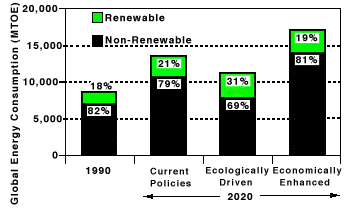 For
the first time, the World Energy Conference divided
the world into eight regions (closely following continental
contours) and conducted in depth study of historical
energy patterns. With that, each region could then
project forward the energy usage in the region. Three
scenarios were assumed: current policy, enhanced economic
policy, and an environmentally driven policy.
For
the first time, the World Energy Conference divided
the world into eight regions (closely following continental
contours) and conducted in depth study of historical
energy patterns. With that, each region could then
project forward the energy usage in the region. Three
scenarios were assumed: current policy, enhanced economic
policy, and an environmentally driven policy.
Figure 3 - Alternative Energy futures
The point we would like to stress is the anticipated ratio of renewable vs. non-renewable energy sources. While the Current Policy case shows the same growth in energy demand as Figure 2, the percentage change in renewable resource use is negligible. The Enhanced Economic Policy assumed a 1% higher economic growth in developing countries -- pushing total energy demand to 17,200 MTOE (million tons of oil equivalent). However, the renewable portion remained at 20%.
The most environmental driven scenario of the World Energy Conference only increases the renewable portion from 20% to 30%.
The Environmentally Driven case assumes greater efficiencies are achieved, hence curbing demand in 2020 to 11,200 MTOE. However, these energy planners see the primary sources of coal, oil, gas and nuclear to remain dominant, and the renewables only growing to 30% in the next three decades.
Climate Change Convention
At the Earth Summit, many computer models were developed to simulate the expected CO2 emissions into the atmosphere CO2 is the main greenhouse gas, and a byproduct of fossil fuel combustion).
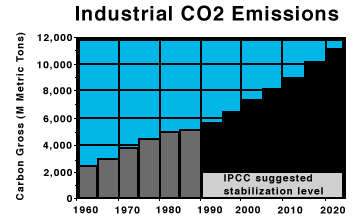 Many
assumptions are made to run these scenarios, yet Figure
5 represents the expectations of most experts in the
field.
Many
assumptions are made to run these scenarios, yet Figure
5 represents the expectations of most experts in the
field.
Figure 4 - Industrial CO2 Emissions
The Intergovernmental Panel on Climate Change (IPCC)
suggested as 60% reduction in CO2 from 1990 levels
if we want to stabilize atmospheric CO2 concentrations.
Going the direction we're headed,
you just can't get there from here
was a poignant
comment heard during the meetings in Madrid.
The Climate Convention targets from the Earth Summit are a pipe dream. You just can't get there from here.
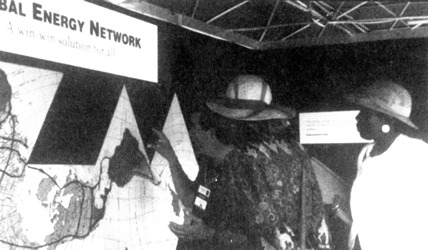 |
|
|
The world is once again embarking on a grand chemistry experiment. Thirty years ago, scientists first warned us of the damage chlorofluorocarbons (CFCs) would do to our ozone layer. Not until a gaping hole appeared over Antarctica did we commit to phasing these chemicals out of production (Montreal Protocol of 1987). And when ozone depletion was found in the northern hemisphere, we collectively accelerated the process.
Some say that prudence should guide our actions. No arguments with that. Yet, some predictions for the future are evident to all, and the emergency just may be upon us today. We, however, won't see the effects until our children are asked to correct them.
Interconnection of Renewable Energy Resources
GENI also learned that our corporate statement -- conducting education and research on connecting international and inter-regional electric energy networks -- is right on target. In every regional review by the World Energy Conference, the interconnection of electric systems is on the agenda, and in some cases a priority.
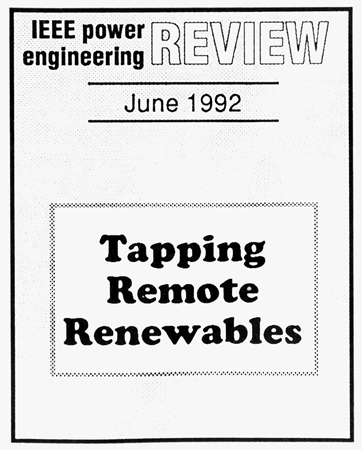 |
|
|
In Africa, the energy community is studying network expansion throughout the continent -- looking to the 30GW hydro potential of the Zaire River for mutual benefit. The Middle East/North African countries are examining a pan-Arab network. System interconnection is a high priority for the entire Latin American region. And the end of the Cold War has allowed almost immediate linkage of East and West Germany, with all of Europe to become interconnected by the end of the decade.
A desirable future prescribes certain choices be made today.
From our previous newsletter, you read excerpts of six experts from a panel session hosted by the IEEE Power Engineering Society earlier this year. That discussion became the cover story of the Power Engineering Review in June, entitled "Tapping Remote Renewables". This has became prophetic, as we learned more of the issues facing us. If GENI is to act as a trimtab, and alter the direction we are headed, our focus must be refined.
The highest priority of the power industry, the developmental organizations and the environmental community is to link the renewable energy resources around the world.
Computer Simulation Model
Over the past few decades, electrical interconnections have become increasingly widespread as technology has improved and the benefits of integrated systems realized. Significant economic benefits have been achieved through interconnected systems, e.g. in North America, Europe, the former USSR and Australia.
Specifically, interconnections provide the following benefits:
- reduced requirement for reserve and spinning
capacities
- improved efficiency
- optimization of energy mix
- load leveling between East/West time zones and
North/South seasonal variations
- postponement of capital investment in new generation
- reduction in fossil fuel emissions and nuclear
waste due to efficiency gains
- improved reliability with regard to reduction of outages, stability of frequency an voltage
Significant progress towards a low emission energy future is possible through the extensive use of interconnections. Many of the large renewable energy sources are located in remote regions, far from load centers. Initially, expanding interconnections will be most viable between regions and ultimately between continents.
Many of the large renewable sources are sited in developing countries. With optimal development, excess power could be exported to developed nations, providing hard currency exchange for the developing country, plus the much needed energy to drive their own economy. An example of this scenario is the proposed Grand Inga project in Zaire with interconnections to Europe. Mutual benefits exist by displacing much of the polluting fossil and potentially unsafe nuclear power in Eastern Europe.
Interconnections are worth in excess of $20 billion per annum to the U.S. economy. The proposed Central American linkage from Columbia to Mexico could net those countries over $1 billion per annum. A recent report from Asea Brown Boveri estimated that greenhouse gas emissions could be replaced by one third from present levels if a realistic and achievable 2000 TWh per annum of renewable (primarily hydro in their study) could be interconnected into existing systems.
The purpose of this research project is to quantify these benefits economically and environmentally, comparing this technology with other solutions using the same benchmarks. These results will quantify the impact of large system planning and prioritize this design scenario in relation to other energy strategies. The ultimate objective is to achieve a low emissions, sustainable energy future for the world, and provide the much needed clean energy to power the economic growth of the world's developing countries. The environmental implications of the developing countries expanding their electricity production in the same manner as the first world, is indeed great cause for concern.
|
The Research Project begins with the investigation of existing models, and the assumptions that lead to their scenarios. Regional systems already being analyzed, as well as essential data will be assembled from sources worldwide. In the GENI study, several scenarios will be modelled:
With the third scenario in mind, we have specified a few of the parameters, and offer them for your consideration:
and then derive the:
|
Mike Fisher, GENI Technical
Director
Research Project Coordinator
THE NEXT STEPS
From Possibility to Opportunity
Project and ideas go through phases, just as
we move through stages of life. After formation, and
for many years, GENI remained just a possibility
in the world. It had high potential, but remained
in the realm of a good idea
.
This year, GENI shifted -- becoming an opportunity
for the planet to pursue. There are enough people
in the world aware of this option, that we must
ultimately choose to walk through the opening,
or not. Just as trains change tracks, today's
choices may involve only a slight deviation from our
previous course -- yet the outcome will be vastly
different as we move into the next century.
Goals for 1993
1. Computer Simulation Model
creates the scenario of interconnecting
renewable resources around the world
, and comparing
this to other accepted models which anticipate only
a moderate push towards renewable and a business-as-usual
scenario. This is a essential tool to reassure the
engineering and financial communities of the desirability
of the project.
2. One Hour Documentary/Film
GENI already has two outstanding 15 minute videos:
What If . . . A new Global Option
and A WIN-WIN SOLUTION
which have
been viewed around the world. An independent production
company is working on a one hour piece for international
television broadcast. The purpose is to educate millions
around the world to this synergistic opportunity.
3. International Conference on Electrical Interconnections
Upon recommendation by the United Nations Environmental Program (UNEP), we have begun formulating plans for this event to be held in Geneva. The qualitative summary of the Winnipeg Workshop, and the above Computer Model, will be the basis for a quantitative analysis in each area: Technical, Economic, Financial, Environmental and Sociopolitical, with implementation groups studying specific inter-regional projects. The designed result is to motivate the financiers and policy makers around the world to make commitments on regional interties.
GENI Milestones
| 1986 | GENI founded to investigate the idea by Buckminster Fuller, proposing a Global Electric Energy Grid as the number one priority to solve many of the world's most pressing problems. |
| 1989 | November. A 15 minute video What
If . . . A New Global Option released to explain
the proposal to the general public. Introduced
by John Denver, the video has been viewed on all
continents. |
| 1991 | February. GENI formed as a non-profit corporation whose purpose is to conduct research and educate all people to the benefits of linking international and inter-regional electric energy networks. |
| 1991 | July. International
Workshop on the Limits of Long Distance High-Voltage
Power Transmission and the Corresponding Economic,
Environmental and Socio-Political Implications.
Hosted by the Manitoba HVDC Research Centre and
GENI, 36 multi-disciplined experts from around
the world gathered in Winnipeg, Canada. They concurred
on the potential benefits of expanding power networks
between nations and continents. |
| 1991 | September. A 15 minute video
A WIN-WIN Solution released,
featuring interviews with a dozen specialists
from the Winnipeg workshop. Strong corroboration
for the initiative is expressed by engineers,
environmentalists and diplomats. |
| 1992 | January. Russians and Americans
met in Anchorage, Alaska to discuss The
Potential of an Electrical Interconnection Between
Russia and North America. Hosted by the Alaska
Energy Authority and GENI, these power engineers
began the study of an underwater linkage between
the two continents, making available the enormous
renewable potential of the region. |
| 1992 | January. Institute of Electrical
and Electronic Engineers, Power Engineering Society
(IEEE/PES) hosted a panel session in New York
on Remote Renewable Energy Sources
made Possible by High Voltage Interconnections.
Panelists state that massive untapped renewable
energy exists, and is available with current technology.
|
| 1992 | March. The United Nations Environment
Program (UNEP) stated that GENI is one of the most important opportunities to further the cause of environmental protection and sustainable development. UNEP agreed to co-sponsor an international conference, deepening the investigation globally, including the financial and diplomatic communities. |
| 1992 | June. GENI exhibit at the Rio
de Janeiro Earth Summit was
seen by thousands from around the world. Relationships
established with energy and environmental research
organizations, as well as NGOs from every continent.
Dozens of press interviews held, including the
Wall Street Journal, Japan's Business Newspaper,
Public Broadcasting and the BBC.
|
| 1992 | June. The IEEE/PES magazine Power
Engineering Review cover story was on Tapping
Remote Renewables. Over 23,000 engineers involved
in research, manufacturing and utility planning
received the article. |
Funding needs for 1993: $1,000,000.
Your generous support
is requested.
How can I support GENI?
Request:
- GENI Source Document
- Get on the mailing list (get on the emailing list )
Request a GENI Video
- A Win-Win-Solution (expert discussion)
- What if... a new global option (general public)
Discuss this proposal and share the GENI video with friends and business associates. (Use the Tell your friends about this page feature below)
Write a letter to your political leaders, especially the Presidents of the U.S. and the U.S.S.R. and the U.N. Secretary General
Contact your local media regarding a feature story on GENI
Arrange a presentation for GENI at your group's luncheon or trade conference
Contribute money or skills to forward the education of this global opportunity
GENI Support and Products
ONE TIME SUPPORT:I want to help GENI now, |
- GENI
Video:
What if... a new global option
This 15 minute video has been seen around the world. Designed for the general public, it's the best overview of the GENI Initiative. Introduction by John Denver.
- GENI T-shirts (no longer offered)
"Connect the World with GENI" — three color shirt along with Dymaxion™ Map and Grid is guaranteed to get attention and conversation. White shirts with Map in blue and yellow, Grid and print in red.
- GENI
Brochures
A concise statement on GENI, as well as the benefits in the areas of economics, the environment, international trade and cooperation, hunger and overpopulation. This piece will explain GENI to your firends in 3 minutes.
- GENI
Source Document and Placement on the GENI
Mailing List
You'll receive documentation and support literature on the Global Energy Grid proposal, priority mailing of hardcopy GENI Newsletters, and monthly e-mail updates on the status of this discussion around the world.
 Dymaxion™
Globe
Dymaxion™
Globe
Folded from the Dymaxion™ Map, this four-color 6" globe generates conversation on global issues and solutions.
- New
GENI Video:
A WIN-WIN Solution
A 15 minute discussion by ten delegates who participated in the International Workshop in Winnipeg, Manitoba, Canada in July 1991. The consensus statement strongly corroborated the GENI initiative as very credible.It's a win-win proposal for everyone involved.
Joe Falson
- Reports,
Maps, Paper Submissions, and Graphs
Complete set of documents from International Workshop, Winnipeg, Manitoba, Canada July 1991 — and Russian/Alaskan Meeting — Anchorage, Alaska, January, 1992. $75 donation.
Dymaxion™ MapBeautiful four color poster printed on heavy-gauge paper. 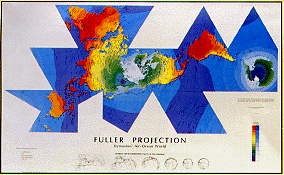
Promises to generate discussions in your home and office.
|
|
ago, the late R. Buckminster Fuller proposed interconnecting regional power systems into a single continuous global electrical energy grid. • While this vision is still years away, tech- nological advances have made the linking of international and inter regional energy networks practicable today. • Transmission lines allow utilities to level the peaks and valleys of demand. This is accomplished between East-West time zones, as well as North-South seasonal variations in demand. • The origin of the energy grid initiative emerged as the highest priority of the World Game™. Its stated purpose is “to make the world work for 100% of humanity in the shortest possible time through spontaneous cooperation without ecological damage or the disadvantage of anyone.” Research reveals that these major benefits will result from expanding electrical networks. • Increase in everyone’s stan- dard of living • Reduction of fossil fuel demand and the resultant pollu- tion • Relief of the population explosion • Reduction of world hunger • Enhancement of world trade • Promotion of international cooperation and peace • The purpose of GENI, Global Energy Network Institute, is to educate all people, especially world leaders, to the potential benefits of this win-win solution. • |
|
Victor Yershevich, Head of Russion Delegation, Directory of Science, Energoset Project |
![]()
How can I support
GENI?
